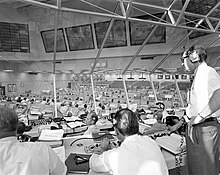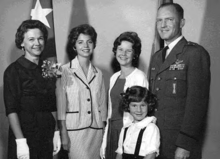Samuel C. Phillips
He helped negotiate the agreement with the United Kingdom for the deployment and use of the American Thor nuclear-armed intermediate-range ballistic missiles.
He brought in Air Force personnel to fill project management positions, and instituted common procedures, documentation and terminology, to prevent potentially catastrophic failures and oversights.
[7] On graduation from the University of Wyoming, where the Reserve Officers Training Corps (ROTC) was compulsory,[5] Phillips was commissioned as a second lieutenant in the infantry.
[4] After the war, Phillips was assigned to the European Theater headquarters in Frankfurt, West Germany,[4] where he served on the G-1 staff, which was responsible for personnel, and was headed by Major General James M.
Phillips's research and development assignments included six years with the Engineering Division at Wright-Patterson Air Force Base, Ohio; duty as an electronics officer with the nuclear weapons experiments at Eniwetok Atoll during Operation Greenhouse; and in project officer assignments with the Boeing B-52 Stratofortress heavy bomber, the AIM-4 Falcon air-to-air missile, and the Bomarc surface-to-air missile programs.
He participated in the negotiation of the agreement with the United Kingdom for the deployment and use of the American Thor nuclear-armed intermediate-range ballistic missile (IRBM), which earned him the Legion of Merit.
Congress accepted that this would be very expensive, and was willing to pay the price to win the Space race, but took a dim view of repeated requests for additional funding simply because of NASA's poor forecasting.
Mueller thought this was due to poor management skills; NASA had expanded rapidly, and its engineers had not worked on projects as large as Apollo.
[12] Mueller asked the head of the Air Force Systems Command (AFSC), General Bernard Schriever, if Phillips could be seconded to NASA as the program controller in the Office of Manned Space Flight (OMSF).
[15] Although Schriever was reluctant to part with one of his top ICBM project managers, he considered that the Air Force's Dyna-Soar and Manned Orbiting Laboratory programs could benefit from NASA experience.
[16] The following month, Phillips wrote to Schriever requesting that Air Force personnel be provided to fill program control positions in the OMSF.
The United States Secretary of the Air Force, Eugene M. Zuckert, agreed to consider the request, subject to NASA providing position statements so that he could ensure that the work would benefit their careers.
Phillips ultimately requested and received the assignment of 128 more officers, most of whom were based at the Manned Spacecraft Center (MSC) in Houston, Texas.
[6] Phillips aggressively took on the job with constant daily meetings, phone contact, and visits to contractor sites which kept him on the road 75 per cent of the time.
[18] Through the institution of common procedures, documentation and terminology, Phillips hoped to prevent potentially catastrophic failures and oversights, and to head off criticism from the media, Congress and the Government Accountability Office.
[19] In November 1965, Phillips personally took a tiger team to North American Aviation (NAA) in Downey, California, the prime contractor for the Apollo Command/Service Module (CSM) and the Saturn V's S-II second stage, to investigate problems of delays, quality shortfalls and cost overruns.
[20] On 19 December, he wrote a memo to NAA president Lee Atwood with a copy of a report of his findings and some recommended fixes, which he also sent to Mueller.
Phillips privately wrote to Mueller recommending that the president of NAA's Space and Information Systems Division, Harrison Storms, be replaced.
Atwood brought Robert Greer, a retired Air Force major general, in to manage the S-II project at NAA.
Grumman adopted a system of "work packages", under which the project was broken down into discrete tasks, each with its own personnel, budget and manager, but this did not resolve all of its problems.
NASA Administrator James E. Webb was called before Congress and when questioned by Senator Walter Mondale, he testified that he was unaware of the existence of the report.
Safety offices were established at every NASA field center in September 1967, and the following month the MSC created the Spacecraft Incident Investigation and Reporting Panel.
[18][8] During the Apollo 11 mission in July 1969 which achieved the program's manned landing goal, Phillips announced his intention to leave NASA and return to Air Force duty.
[6] On 26 September 1971, Phillips was awarded the Smithsonian Institution's Langley Gold Medal in aviation and space exploration for his contributions to the Apollo Program from 1964 to 1969.





